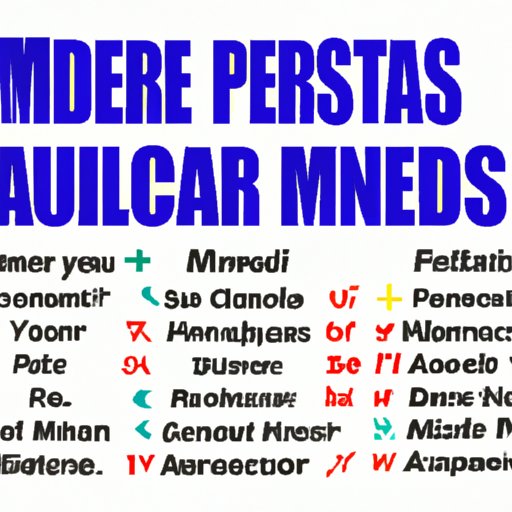Introduction
Medicare is a federal health insurance program that provides coverage to millions of Americans who are age 65 and older, as well as certain younger individuals with disabilities. The program is divided into four main parts – Part A, B, C, and D – each offering different types of coverage. It is important for seniors to understand the different parts of Medicare in order to make an informed decision about their healthcare coverage.

Explaining the Different Medicare Parts: A Guide for Seniors
Medicare Part A is also known as hospital insurance. This part of Medicare covers inpatient hospital care, skilled nursing facility care, hospice care, and some home health services. Medicare Part B covers physician services, outpatient hospital services, and other medical services, such as lab tests and durable medical equipment. Medicare Part C, also known as Medicare Advantage, is a private health plan that is run by a private insurer and approved by Medicare. Medicare Part D is a prescription drug plan that helps cover the cost of prescription drugs.

What You Need to Know About the Different Medicare Parts
In order to choose the right Medicare plan for you, it is important to understand the coverage and costs associated with each part. All Medicare plans have eligibility requirements; some may require you to pay premiums or co-pays for certain services. Additionally, you will need to determine if you qualify for any special programs, such as those related to low-income households.
Comparing and Contrasting Medicare Part A, B, C, and D
When comparing the different parts of Medicare, it is important to consider the benefits, cost, and coverage of each. Medicare Part A offers coverage for inpatient hospital care, skilled nursing facility care, hospice care, and some home health services. Medicare Part B covers physician services, outpatient hospital services, and other medical services. Medicare Part C is a private health plan offered through a private insurer that is approved by Medicare. Medicare Part D is a prescription drug plan that helps cover the cost of prescription drugs.
The cost of each part of Medicare varies depending on your individual situation. Generally, Medicare Part A has no premium, while Medicare Part B and Part D premiums vary depending on your income level. Medicare Part C premiums are set by the private insurer. Additionally, all parts of Medicare have deductibles and coinsurance amounts that must be paid out of pocket.
An Overview of the Different Medicare Parts
It is important to understand how Medicare works in order to make an informed decision about which parts to enroll in. Medicare is divided into four parts: Part A (hospital insurance), Part B (medical insurance), Part C (Medicare Advantage), and Part D (prescription drug coverage). Each part of Medicare offers different coverage and costs, so it is important to research your options and compare plans before making a decision.

How to Choose the Right Medicare Plan for You
When choosing a Medicare plan, it is important to consider your current needs. You will need to determine what type of coverage you need, as well as how much you can afford to pay in premiums and out-of-pocket costs. Additionally, you should consider important factors such as eligibility requirements, coverage limits, and other restrictions. Comparing plans side by side can help you find the best option for you.
Benefits of Enrolling in Medicare Part A, B, C, and D
Enrolling in Medicare Part A, B, C, and D offers many benefits. These include access to healthcare services, financial protection against medical expenses, and more. Additionally, many people find that enrolling in a Medicare plan can help them save money on their medical expenses in the long run.
Understanding the Different Medicare Parts: A Beginner’s Guide
If you are new to Medicare, it can be confusing to understand the different parts and how they work. This beginner’s guide can help you get started. First, it is important to understand the basics of Medicare and how it works. Next, you can familiarize yourself with the different components of Medicare and the different types of plans available. Finally, you can use this guide to help you find the right plan for you by considering important factors such as cost, coverage, and eligibility.
Conclusion
Understanding the different parts of Medicare can be daunting, but it is important for seniors to know their options. This guide has provided an overview of the different Medicare parts, including information about coverage, costs, and eligibility. Additionally, it has given tips for finding the right plan for you. Now that you have a better understanding of the different Medicare parts, you can start researching your options and making an informed decision.
(Note: Is this article not meeting your expectations? Do you have knowledge or insights to share? Unlock new opportunities and expand your reach by joining our authors team. Click Registration to join us and share your expertise with our readers.)
